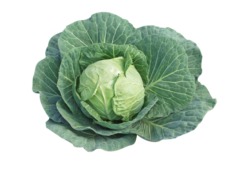Cabbage

The Celts brought cabbage, yet another brassica, to Europe from Asia around 600 B.C. Since cabbage grows well in cool climates, yields large harvests, and stores well during winter, it soon became a major crop in Europe, though the varieties we grow today are larger and more prolific than the originals. It is very easy to grow, providing the normal rules of horticulture are observed and, if grown in good soil, is a Class A health food. The health benefits of cabbage include treatment of constipation, stomach ulcers, headache, excess weight, skin disorders, eczema, jaundice, scurvy, rheumatism, arthritis, gout, eye disorders, heart disease, ageing, and Alzheimer's disease. On top of this, it contains very few calories, so is a must in the diet of the weight-conscious.
Sadly, its image is not good, particularly amongst the young, so more effort is needed on the marketing side. This may be due to our heritage of institutional food, when everything was boiled to death with the water (and 90% of the nutrients) then poured away. The smell of overcooked cabbage haunts us still.
It is to be hoped that the wide range of newly available varieties of cabbage, Savoy, Red, Napa, Bok Choy, Hispi and others, will tempt new customers for this excellent brassica, which can be eaten raw in salads, steamed or stir-fried.
Field Science has experience in treating soils for brassica production with excellent results. As with all plants, it is imperative that the plants can acquire the correct balance of nutrients as and when required, through the soil as Nature intended. This is achieved through the application of tailored trace element dressings. On treated ground you can expect to see more resilient plants with better leaf strength, better resistance to disease/fungal attack and most likely a better flavour. Shelf life extension has also been reported.
The Dressing Process
Field Science tailored mineral dressings are always based on detailed soil analysis of the field to be treated. A member of our technical team will visit your farm to discuss and identify where we can help. Soil samples are then taken and the tailored dressings are based on the independent laboratory’s results.
The Single Crop Dressing is the best option for cabbages as the soil is usually ploughed after harvest and that would effectively bury a multi-year dressing out of reach of the roots.
The best time for application is just after emergence or planting-out of module-grown plants. The application rate is usually 25kg per hectare (10kg/ac) and the most effective method of application is to use an electric spinner (slug-pelleter) on a quad bike. The dressings are packed in 25kg bags, clearly labelled with the farm details, field name, application rate and bag weight.
